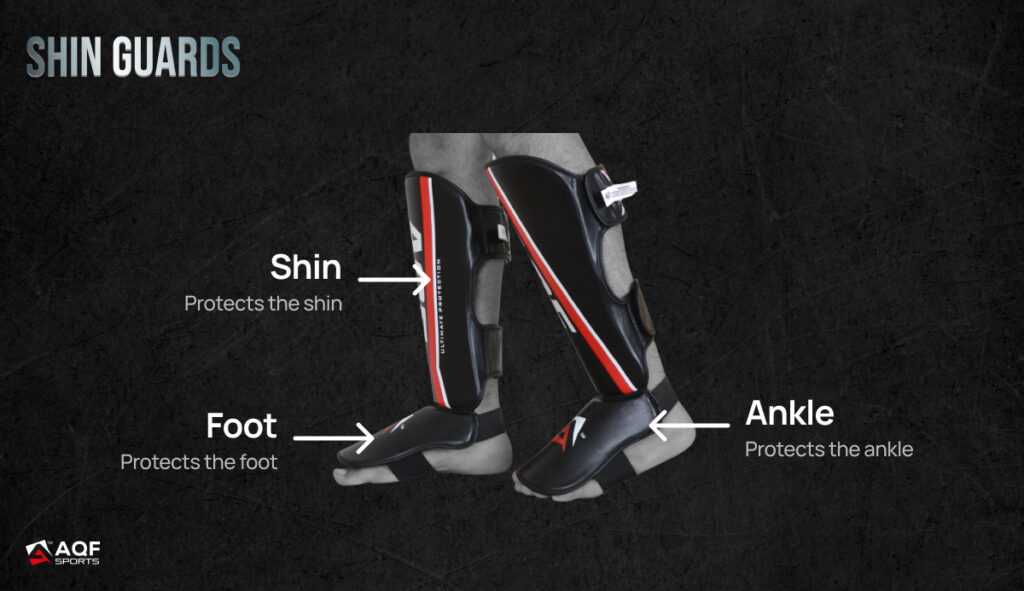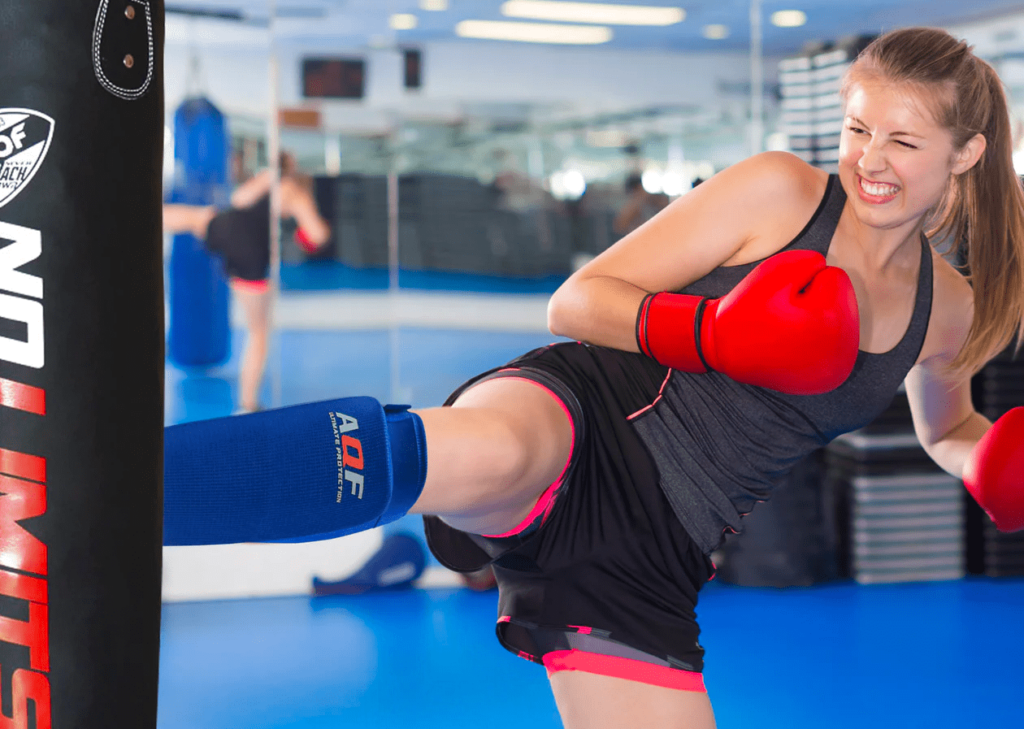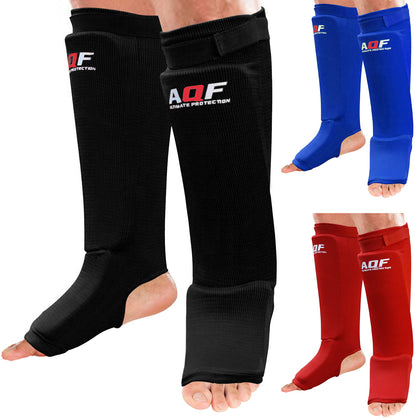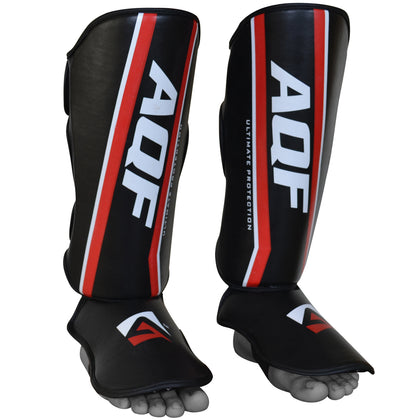How to Wear a Shin Guard? [Complete Guide]
![How to Wear a Shin Guard? [Complete Guide]](https://blog.aqfsports.com/wp-content/uploads/2023/07/image7-2.jpg)
We all know that feeling, right? That moment of hesitation right before throwing a kick – wondering if you will end up with a painful shin injury. But fret not, because we’ve got your back (or should I say shins?) with the ultimate guide on how to wear a shin guard.
In this article, we’ll discuss why shin guards are such a big deal in the combat sports world and why using them correctly is crucial. No more uncertainty or discomfort – we’ve curated a treasure trove of tips and advice to help you pick the perfect shin guard and release your kicking potential!
Whether you’re a seasoned athlete or just starting your combat journey, we’ve got you covered. From finding the right fit to understanding different materials, we’ve got all the essential info in one place. So, say goodbye to shin injuries and hello to confident, protected kicking!
Are you ready to gear up and kick like a boss? Let’s jump into this shin guard guide together and level up your game! Get ready to rock those shin guards and dominate the ring like a true champ! Let’s do this!
Why Do You Need to Wear Shin Guards?
Ready to hit the MMA ring with all you’ve got? Before you exhibit MMA or Muay Thai Skills, remember one thing: protect your shins!
Shin guards are your best buddies for foot safety, top-notch performance, and learning new techniques. You might be wondering why do you need to wear shin guards, really?
So, let’s break it down for you:
Foot Protection
Ouch! One strong kick from your opponent could leave you nursing painful injuries.
Shin guards are your foot’s shields that absorb impact, prevent contusions and protect your foot from fractures. Research shows that fighters with shin guards have fewer shin injuries. (Source)
Shin Splints
Shin guards support your leg and evenly distribute impact force to reduce painful shin splints. Shin Splints or “Spike Soreness” in athletes occur due to excessive impact on hard surfaces. (source) This more time training in the ring and less time tending to your injuries!

Better Performance
Confidence is key! Shin guards protect your vulnerable leg anatomy and make you feel invincible. This boosts your performance aggression and gives you a competitive edge. (Source)
Rapid Movements
Move swiftly like a true MMA fighter! Modern shin guards are lightweight and adhere to the contour of your leg to improve your agility and reflexes. (Source)
Improve Technique
Shin guards protect your shin during sparring so you can perfect those killer kicks and knee strikes. This improves your defence and offence techniques.
Muay Thai Kicking: Target Zone and Strike Zone
Alright, let’s talk kicking techniques! When it comes to delivering those powerful kicks, there are two main zones to focus on – the target zone and the strike zone.
Target Zone – Zeroing in on Your Opponent’s Thigh:
Imagine your opponent’s thigh as your bullseye! That’s your target zone. For a killer kick, aim for both the inside and outside of their thigh. Hit that spot, and you’ll have them wincing in no time!
Strike Zone – Unleashing the Shin Strike:
Now, let’s talk about the strike zone – it’s all about your shin! The sweet spot for landing devastating kicks is the mid to lower part of your shin, right above the ankle. Trust me, that’s where the magic happens!

But here’s a big NO-NO – avoid using your foot for kicks! Your foot’s got over a hundred tiny muscles, 26 little bones, and 30 joints. One wrong move, and you could end up with a painful injury. Ouch!
Stick to your shin for safe and powerful strikes!
Speaking of safety, let’s talk about the importance of shin guards!
Shin Guards – Your Armor Against Foot Injuries:
When you’re training in Muay Thai, shin guards are your trusty sidekicks! They’re like your superhero armour, protecting your shin, foot, and ankle from potential injuries. See, we want you to kick with confidence, knowing you’re safe and ready to take on anything!
During training, accidents can happen, and you might end up landing a kick with your foot instead of your shin. That’s where shin guards come in handy, preventing those nasty foot-related mishaps.
And let’s not forget the classic ‘checking the kick’ move! When your opponent throws a leg kick at your thigh, you can raise your knee to block the point of your knee or the top of your shin. Guess what? Shin guards got your back in that battle, making sure both your attacking and defending shin areas are protected like champs!
Remember, during pro competitions, you won’t wear shin guards, but for training – it’s a must! So, gear up, and unleash those kicks like a boss using shin guards!

Ready to kick some serious butt? Hell yeah!
Here Is How Your Body’s Anatomy Works During MMA and Muay Thai Training
In order to understand which areas of your leg and foot are most vulnerable to kicks and injuries, let’s get take a look at your leg’s anatomy and see how each part plays its role during MMA and Muay Thai:
Lower Leg Anatomy
Shin:
This is the front part of your lower leg, and plays an important role during offence and defence. When you deliver those powerful shin kicks (also known as shinbone kicks) or use your shin to block kicks, this tough and resilient shin bone takes the brunt.
Calf:
The calf muscles in your lower leg are like coiled springs ready to power up! They generate power during kicks and support quick footwork so you can nail those lightning-fast moves in the ring.
Ankle:
Ah, the unsung hero of balance and stability! Your ankles work tirelessly to stabilise you during dynamic movements and quick changes in direction, which are fundamental in MMA and Muay Thai.
Achilles Tendon:
The strong and mighty Achilles tendon connects your calf muscles to your heel. It’s like the powerhouse that provides you with the force needed to propel forward during those kick-aggressive attacks.
Foot Anatomy

Your foot’s anatomy is very complex mechanically and structurally. Each of your feet is composed of 26 small bones connected with 33 joints by hundreds of small ligaments, tendons and muscles. All these components work together – like an intricate engine – to allow weight bearing, forceful kicks and swift movements.
The Dorsum:
It is the top part of your foot. The dorsum might not look like a big deal, but it’s the star player in the ring. When you throw those powerful front kicks and sneaky push kicks (we call them teeps), it’s the dorsum in action.
The Metatarsals:
Now, meet the frontline warriors – the metatarsals! These are the bones running along the front of your foot – through your toes ad fingers. Metatarsals come into action during roundhouse kicks and sidekicks.
Each of your feet has 5 metatarsals and the biggest one, called the Hallux, is found in your toe. So, it’s important to protect these delicate bones during intense training sessions.
The Sole:
Quick movements win the game in the ring, right? While you move make sure you stay balanced and nimble during all those moves and combos.
The Heel:
The heel is the anchor of your foot and keeps you grounded. It brings power and stability to your foot when you throw those mighty stomp kicks or land brutal knee strikes in the clinch.
The Arch:
Arch acts like a natural cushion to soften the impact of kicks and jumps. It’s like your very own shock absorber in the ring.
Given this complex yet vulnerable foot anatomy, wearing hin guards in the ring is essential to protect your muscles, bones and ligaments from impact and injuries.
A Look Inside the Shin Guard Design

A typical shin guard consists of several components designed to provide maximum protection and comfort. The main components of a shin guard are
Shell:
The outer hard layer of the shin guard, usually made from durable materials like plastic or fibreglass. It serves as the primary shield to absorb impact and protect the shin from direct blows.
Padding:
The inner layer of the shin guard, often made from foam or gel materials. The padding helps cushion the impact and reduces the force transmitted to the shin during kicks or blocks.
Straps or Closure System:
Shin guards come with straps or a closure system to keep them securely in place during training or matches. Common closure options include Velcro straps or elastic bands.
Ankle Protection (Optional):
Some shin guards feature extended padding around the ankles for additional protection and support.
Ventilation: To prevent excessive sweating and discomfort, some shin guards have ventilation holes or channels to allow air circulation.
Contouring and Flexibility:
The design of the shin guard may include contours to fit the shape of the leg better, ensuring a snug and comfortable fit. Flexibility is essential to allow natural movement and a full range of motion during combat sports.
Lining:
The interior of the shin guard may have a soft lining for added comfort and to prevent irritation during use.
How to Wear Shin Guard Properly?
Step 1: Preparation
Clean and dry your legs before wearing shin guards to prevent slipping discomfort.
Step 2: Unwrap and Place the Shin Guards on Your Leg
- Position the shin guards to cover your shinbone, from just below the knee to the ankle.
- Ensure they sit flat against the front of your leg for effective protection.
Step 3: Secure the Shin Guards
- Use adjustable straps or sleeves to secure the shin guards in place.
- Fasten them snugly without restricting blood flow or causing discomfort.
Step 4: Comfort and Flexibility
- Check for a full range of motion by bending your knees and ankles.
- Adjust removable padding, if available, for extra comfort and support.
Step 5: Double-Check the Fit
- Stand upright to confirm the shin guards cover your shinbone properly.
- Perform gentle kicks and movements to ensure they stay in place during action.
Step 6: Regular Inspection
- Before each use, inspect the shin guards for wear or damage.
- Replace worn-out guards to maintain optimal protection.
How to Clean and Store Shin Guard for Long-Term Use
No one likes stinky gear, right?
Hygiene is crucial in and out of the ring. Regular maintenance keeps your shin guards fresh and germ-free.
Here is what we recommend:
- After training, use a damp cloth to wipe off sweat and dirt from the shin guards. Tossing shin guards in the washer or dryer is a big no-no!
- Use mild soap and a soft brush to scrub gently and deep-clean the shin guards. Rinse well and let them air dry. Easy peasy!
- Use a shin guard bag or wrap them in a soft cloth for safe storage. Let shin guards air dry completely before putting them away.
That’s it! Simple steps to keep your shin guards in mint condition.
Common Mistakes to Avoid When Wearing Shin Guards
Hey fighters, let’s talk about those shin guards and how to avoid common blunders. We want you to stay safe and kick like champs! Check out these easy tips:
Wrong Positioning: Cover your entire shin properly down to your ankle.
Loose Fit: Shin guard should cover your leg contours but it should not be too tight.
Improper Kicking Technique: Kick with your shin, not your foot during sparring sessions.
How to Adapt to Shin Guards?
Don’t worry if the shin guard feels odd and uncomfortable at first. Give it some time to adjust to your leg’s shape, and you’ll eventually get used to wearing shin guards.
Practice Specific Techniques and focus on moves that complement shin guards. Practice checking kicks and perfecting shin strikes.
Pro Tips to Enhance Performance Wearing Shin Guards
- Make Shin Guards Your Training Staple and wear them during kicking drills to get comfortable with their feel and movement.
- Condition Your Shins by performing exercises like shin kicks using shin pads or heavy bags to toughen up your shins and improve impact absorption.
- Pair Shin Guards with Protective Gear like gloves, mouthguards, and headgear for all-around protection.
- Gradually Increase Intensity: Start slow and build up your combat techniques as you feel more confident wearing shin guards.
Does Wearing a Shin Guard Affect Shin Conditioning?
Alright, let’s tackle the burning question – does wearing a shin guard mess with your shin conditioning in Muay Thai? It’s a topic that gets fighters talking a lot.
You know shin conditioning is similar to toughening up your shins to handle those hard-hitting kicks without flinching. But here’s the twist – some folks say wearing shin guards during training might slow down that process.

Why? Because the shin guards padding softens the impact and reduces the direct effect needed for shin toughening.
But that’s not the case!
Shin guards do not mess with your shin conditioning as long as you properly tighten them.
No guesswork here, folks! Before strapping those shin guards on, make sure that you have secured them in the right place. Shin Guard should cover your shinbone from just below the knee down to the ankle. We want your whole shin protected like a champ when you’re throwing those lethal kicks and blocking like a boss!
Nobody likes a slipping shin guard surprise during combat, right? Check the shin guard fitting – it should be snug and secure! Fasten the straps properly to avoid any distractions messing with your focus in the heat of battle!
Tips for Maintaining Proper Shin Guard Alignment:
- Here’s the deal – kicks and blocks can throw your shin guards out of whack. No worries, though! Between rounds or during breaks, quickly adjust the shin guards to protect your shins.
At the end of the day, it’s about finding that sweet spot that works for you!
- Use shin guards during heavy training sessions for protection, and practice without ’em to toughen up those shins. Balance is key.
- Remember, we’re all different. Listen to your body and adapt your training style accordingly. With consistent effort, your shins will be unbreakable! So, keep kicking, training, and conditioning – and leave those shin guard debates in the ring! You’ve got this!
What Things to Look For When Buying a Shin Guard?
Look for the following things when buying a shin guard:
Size and Fit:
Measure your shin’s length and width to find the perfect size. The guards should cover your entire shin, from just below the knee to the ankle, ensuring complete protection. Try them on before buying to ensure a snug fit.
Comfort:
Look for shin guards with soft padding and a comfortable inner lining. Consider ones with ergonomic designs that conform to the shape of your legs. A good fit means less slipping and irritation during training or matches.
Material:
Check the materials used in the shin guards. Foam padding provides excellent shock absorption, while hard plastic shells offer solid impact resistance. Gel padding can provide a combination of comfort and protection. Choose the one that suits your needs and playing style.
Closure System:
Decide between Velcro straps and slip-on guards. Velcro straps allow for a customizable fit, making them great for securing the guards firmly in place. Slip-on guards are quick to put on and take off, ideal for convenience.
Ankle Supports:
If you’re prone to ankle injuries or need extra stability, consider shin guards with extended padding around the ankles. These ankle shin guards provide added protection and support.
Breathability:
Look for shin guards with breathable materials or ventilation channels. Proper ventilation prevents excess sweating, keeping your legs cool and dry during intense matches.
Mobility:
Test the mobility of the shin guards before purchasing. You should be able to move freely without feeling restricted. Look for guards with a contoured design that allows a full range of motion for your kicks and footwork.
Durability:
Invest in quality shin guards that can withstand rigorous training and matches. Check for strong stitching, reinforced materials, and durable padding to ensure they last longer.
Sport-Specific Design:
Consider the sport you’ll be playing. Some shin guards are designed specifically for soccer, while others may be tailored for MMA or other combat sports. Choosing sport-specific guards ensures optimal performance and protection.
What are the Different Types of Shin Guard Closures?
There are three main types of Shin guards closure,
Slip-On Shin Guards [Basic]
These are the simplest and most basic type. As the name suggests, you slip them on like socks. They’re lightweight and easy to put on, making them ideal for beginners or casual players.
Velcro Closure Shin Guards [Custom Fit]
These shin guards come with adjustable Velcro straps, allowing you to customize the fit. They offer a more secure and snug feel compared to slip-on guards. They’re great for intermediate players or those looking for a bit more support.
Ankle Shin Guards [More Protection]
As the name implies, these guards provide additional ankle protection. They typically have extended padding around the ankle area, offering extra support and shielding against impacts.
-

AQF Shin Instep Guards Elasticated
£11.99
Buy Now -

AQF Shin Instep Guards Synthetic Leather
£25.99
Buy Now
Shin Guards – Frequently Asked Questions
Q: Why do I need to wear shin guards in combat sports?
A: Shin guards are essential for protecting your shins from potential injuries during intense training and matches. They absorb impact from kicks and blocks, reducing the risk of painful bruises, fractures, or cuts.
Q: How do I choose the right size of shin guards?
A: To find the perfect fit, measure the length of your shin from just below the knee to the ankle. Match your measurements with the sizing chart provided by the manufacturer to ensure proper coverage and protection.
Shin Guards Sizing Chart
Q: Can I use the same shin guards for different combat sports?
A: While some shin guards are versatile and can be used across various sports, it’s best to choose sport-specific shin guards for optimal performance and protection. Different combat sports may have specific design features to cater to their unique demands.
Q: How often should I clean my shin guards?
A: Cleaning your shin guards regularly is crucial to maintain hygiene and prevent unpleasant odours. Wipe them down after each session with a damp cloth. For a deeper clean, use mild soap and water, and allow them to air dry completely before storing.
The Bottomline
Shin guards are your ultimate allies in the ring. Throughout this guide, we’ve emphasized the importance of shin guards and shared useful tips on how to wear a shin guard properly to avoid discomfort.
Remember three golden rules to wear a shin guard properly: find the right fit, choose quality materials, and pair them with other protective gear for overall safety.
Proper shin guard fitting will boost your confidence and elevate your performance in the ring. With the right gear, you can focus on honing your fighting skills and delivering powerful strikes without worry.
Related Reads,





